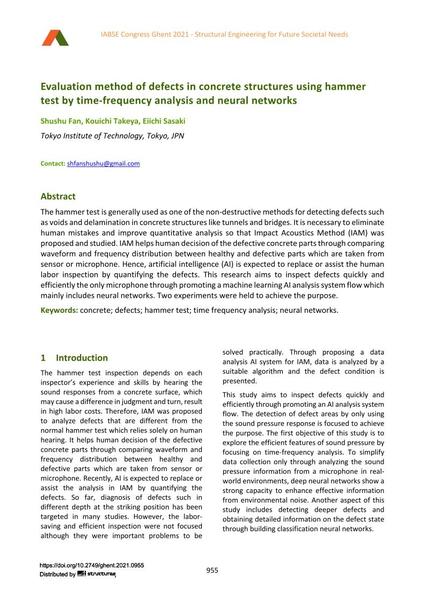Evaluation method of defects in concrete structures using hammer test by time-frequency analysis and neural networks

|
|
|||||||||||
Bibliografische Angaben
| Autor(en): |
Shushu Fan
(Tokyo Institute of Technology, Tokyo, JPN)
Kouichi Takeya (Tokyo Institute of Technology, Tokyo, JPN) Eiichi Sasaki (Tokyo Institute of Technology, Tokyo, JPN) |
||||
|---|---|---|---|---|---|
| Medium: | Tagungsbeitrag | ||||
| Sprache(n): | Englisch | ||||
| Tagung: | IABSE Congress: Structural Engineering for Future Societal Needs, Ghent, Belgium, 22-24 September 2021 | ||||
| Veröffentlicht in: | IABSE Congress Ghent 2021 | ||||
|
|||||
| Seite(n): | 955-964 | ||||
| Anzahl der Seiten (im PDF): | 10 | ||||
| DOI: | 10.2749/ghent.2021.0955 | ||||
| Abstrakt: |
The hammer test is generally used as one of the non-destructive methods for detecting defects such as voids and delamination in concrete structures like tunnels and bridges. It is necessary to eliminate human mistakes and improve quantitative analysis so that Impact Acoustics Method (IAM) was proposed and studied. IAM helps human decision of the defective concrete parts through comparing waveform and frequency distribution between healthy and defective parts which are taken from sensor or microphone. Hence, artificial intelligence (AI) is expected to replace or assist the human labor inspection by quantifying the defects. This research aims to inspect defects quickly and efficiently the only microphone through promoting a machine learning AI analysis system flow which mainly includes neural networks. Two experiments were held to achieve the purpose. |
||||
| Stichwörter: |
Beton
|
||||
| Copyright: | © 2021 International Association for Bridge and Structural Engineering (IABSE) | ||||
| Lizenz: | Die Urheberrechte (Copyright) für dieses Werk sind rechtlich geschützt. Es darf nicht ohne die Zustimmung des Autors/der Autorin oder Rechteinhabers/-in weiter benutzt werden. |
||||
